355 Search Results for assessment
December 12, 2019
by Carole Zangari -
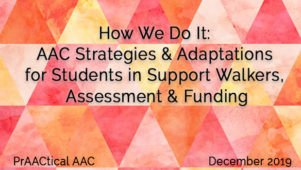
How can we reduce the negative impact of significant motor challenges on children who use AAC and are not independently mobile? Today, we conclude Christine Wright-Ott’s series on this topic. Christine is an Occupational Therapist and consultant at The Bridge School in Hillsborough California. She authored the chapter, Mobility, in several editions of the book, Occupational Therapy for Children. Christine lectures at universities and conferences including ATIA, Closing the Gap, ISAAC, ISS, and AAC by the Bay. If you missed the earlier posts in this series you can catch up via the links below. Part 1: From Wheelchair to Walker: The Cascading Benefit of Hands-Free Mobility Part 2: From Wheelchair to Hands-free Walker for Preschool Children with AAC Needs Part 3: How We Do It: A Support Walker Mobility Program for Elementary Students with AAC Needs ::::::::::::::::::::::::::::::::::::::::::::::::::::::::::::::::::::::::::::::::::::::::::: AAC Strategies, Adaptations for Students in Support Walkers, Assessment & Funding AAC Strategies and... [Read More...]
October 3, 2019
by Carole Zangari -
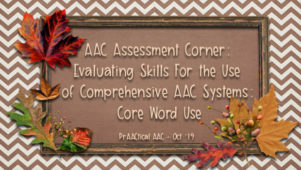
We are so very pleased to welcome Vicki Clarke back to these pages for another installment in our AAC Assessment Corner. Vicki is the CEO of Dynamic Therapy Associates and Director of DTA Schools, is back with another wonderful edition of AAC Assessment Corner. In addition to their clinic, Vicki and her team support school districts in AAC evaluation, equipment procurement, and implementation for individual students in the academic environment. DTA Schools also supports district-wide AAC implementation through the Classroom Communication Goals Project, training, and supporting all team members in classroom AAC implementation. :::::::::::::::::::::::::::::::::::::::::::::::::::::::::::::::::::::::::::::::::::::::::::::::::::::::::::::: Evaluating Skills For the Use of Comprehensive AAC Systems: CORE WORD USE ACTION/OBJECT REQUESTS-RECURRENCE, CESSATION, ACTION More, Stop, Go and Want Once we have assessed our student’s ability to understand and use photos and symbols for concrete, motivating items, it’s time to take a look at their ability to understand and use more abstract, generalizable core vocabulary. ... [Read More...]
August 14, 2019
by Carole Zangari -
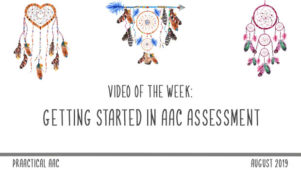
Looking for information on doing AAC assessments? Today, we turn to Saltillo to an archived webinar by SLP Heather Miller Schwarz that covers some of the things you’ll need to know to get started. Direct Link to Video: https://www.youtube.com/watch?v=DyhCerq6SAY
April 25, 2019
by Carole Zangari -
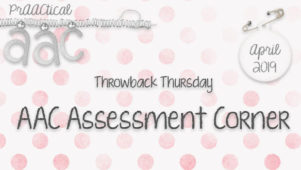
It’s another Throwback Thursday and today we’re turning our attention to assessment. Join us as we revisit “AAC Assessment Corner with Vicki Clarke.” Ready, SETT, AAC Evaluate! AAC Skills Assessment for Direct Selectors Standardized Tests For AAC Users AAC Assessment for Emergent Communicators The Eyes Have It-Assessment Considerations for High Tech Eye Gaze Access Is AAC Feature Matching Still Relevant? Thinking Inside the Box for AAC Evaluations Procedural Resources Evaluating Skills for Use of Comprehensive AAC Dynamic Display SGDs Language Representation Elements – Noun Symbol Use for Functional Communication
March 6, 2019
by Carole Zangari -
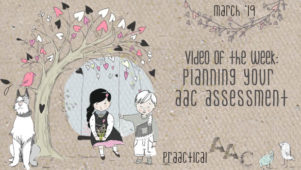
Planning AAC evaluations can be confusing and overwhelming. Wouldn’t it be wonderful if there was a tool to guide us in planning what sorts of assessment activities to do with the various individuals on our caseloads or in our classrooms? Today, we look at the AAC Assessment Planning Tool (APT) developed by the Grant Wood Area Education Agency AAC Resource Team team in Iowa. In this short video, you learn about the APT. Check out this slide deck for more on the APT. You can download the APT here. Many thanks to everyone at Grant Wood AEA for creating and sharing this wonderful tool. Direct Link to Video – https://www.youtube.com/watch?v=5NmgSSWqA8I&feature=youtu.be
June 11, 2018
by Carole Zangari -
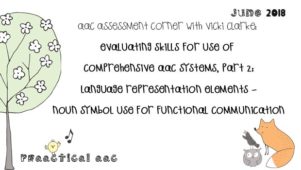
Vicki Clarke, CEO of Dynamic Therapy Associates and Director of DTA Schools, is back with another wonderful edition of AAC Assessment Corner. In addition to their clinic, Vicki and her team support school districts in AAC evaluation, equipment procurement, and implementation for individual students in the academic environment. DTA Schools also supports district-wide AAC implementation through the Classroom Communication Goals Project, training, and supporting all team members in classroom AAC implementation. In today’s post, Vicki shares her thoughts on how we can look at the use of AAC symbols for nouns as part of our evaluations for comprehensive AAC systems. You can view her previous contributions to the AAC Assessment Corner here. :::::::::::::::::::::::::::::::::::::::::::::::::::::::::::::::::::::::: Evaluating Skills For Use of Comprehensive AAC Systems, Part 2: Language Representation Elements – Noun Symbol Use for Functional Communication It was a crazy, busy month full of evaluations, trainings, and report writing. I’ve spent a lot of time with... [Read More...]
May 3, 2018
by Carole Zangari -
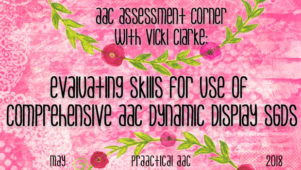
We’re always thrilled to share a guest post on AAC assessment practices from Vicki Clarke of Dynamic Therapy Associates. If you have questions about conducting AAC evaluations, read on. You can view her previous contributions to the AAC Assessment Corner here. :::::::::::::::::::::::::::::::::::::::::::::::::::::::::::::::::::::::::::::::::::: Evaluating Skills for Use of Comprehensive AAC Dynamic Display Systems Part I: Early Skills Over the past few years there has been an on-going discussion in the speech language pathology world about whether or not we needed to designate an official “specialty” recognition for augmentative and alternative communication practitioners. The argument goes something like this: It takes a lot of extra training, concerted effort in continuing education and daily practice in the assessment and implementation of augmentative communication to do it well. Therefore, we should have a “specialty area” in our national organization, ASHA, devoted to AAC. The counter-argument states that if our governing body says you need to... [Read More...]
December 6, 2017
by Carole Zangari -
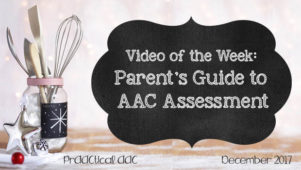
When your child has little or no functional speech, it is tempting to jump right into purchasing AAC technology and get started with therapy and instruction. Usually, though, it helps to slow down just a bit. Families who are new to this journey may not realize that the best way to get started is with a good AAC assessment, and, thus, will not know to advocate for that at school or with private service providers. In today’s featured video, Dr. Jill Senner explains the rationale for starting with an AAC assessment and provides an overview of the process. Enjoy! Direct Link to Video – https://www.youtube.com/watch?v=D7uGjxZDD7I&feature=youtu.be
October 19, 2017
by Carole Zangari -
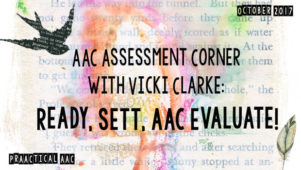
She’s bAACk! We couldn’t be happier to have another guest post on AAC assessment practices from Vicki Clarke of Dynamic Therapy Associates. In today’s post, she shares her tips and experiences for applying the SETT Framework to AAC assessment. If you are looking for information about how AACtual SLPs conduct their evaluations, Vicki’s posts are just what you need. You can view her previous contributions to the AAC Assessment Corner here. :::::::::::::::::::::::::::::::::::::::::::::::::::::::::::::::::::::::::::::::::::: Ready, SETT, AAC Evaluate! Last week I had the pleasure of joining the AAC After Work online conference hosted by Yapp Guru University. Jenna Coyer and I presented a session chatting about AAC assessment in emergent communicators. As we have worked to define our process for evaluation, we found ourselves repeatedly returning to the same approach our Assistive Technology teams use—the SETT Framework. The SETT Framework was developed by Joy Zabala as a process for making decisions about... [Read More...]
May 3, 2017
by Carole Zangari -

There aren’t many formal assessment instruments designed expressly for people who need AAC, so it’s important to know about the ones that are available. In today’s post, we feature two videos on the Test of Aided Communication Symbol Performance (the TASP). Authored by Dr. Joan Bruno (creator of the Gateway programs for SGDs and AAC apps), this test helps us answer some of the questions we have when selecting or creating AAC systems for people with complex communication needs. In this first video, we get a brief overview of the TASP from Dr. Lori Geist. Next, let’s hear more about it from practicing clinicians and see a demonstration of some of the subtests. Do you use formal testing in your AAC assessments? We’d love to hear about those experiences.









